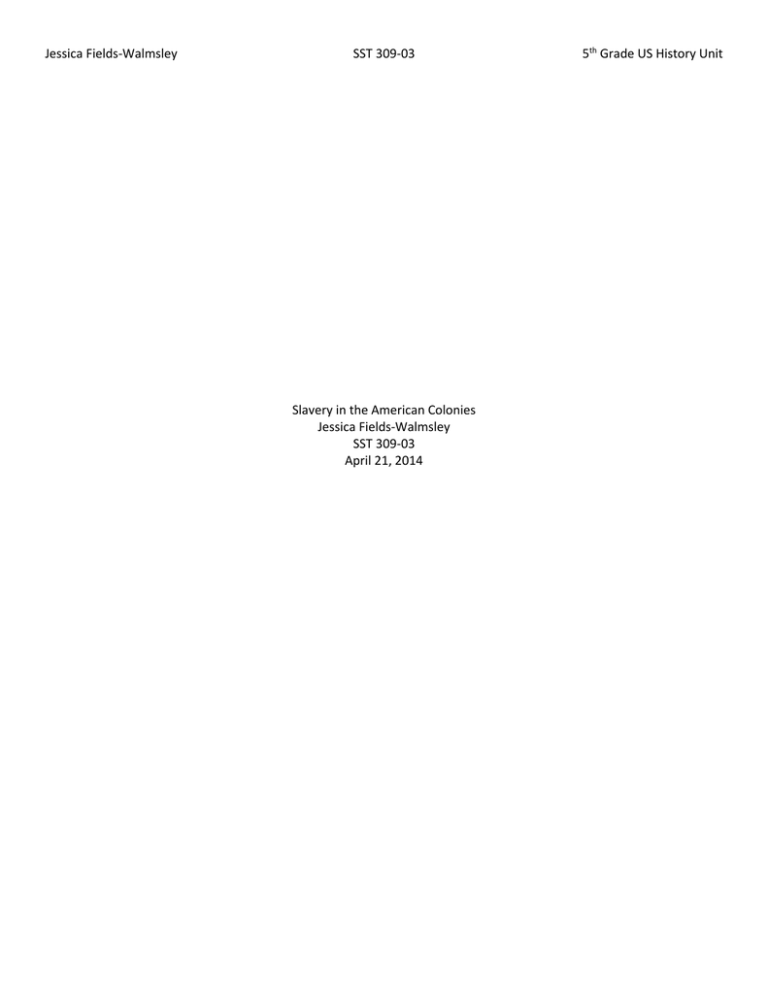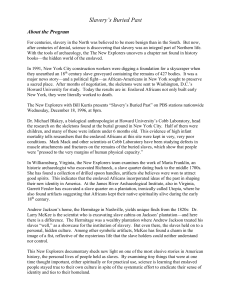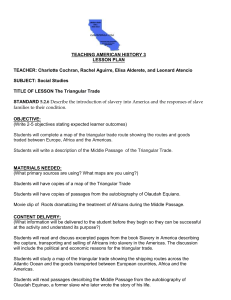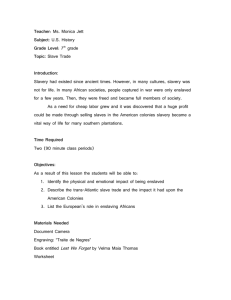5th Grade History Unit - JESSICA FIELDS
advertisement

Jessica Fields-Walmsley SST 309-03 Slavery in the American Colonies Jessica Fields-Walmsley SST 309-03 April 21, 2014 5th Grade US History Unit Jessica Fields-Walmsley SST 309-03 Table of Contents Introduction KUD and I can statements Final Assessment Vocabulary Lesson 1: Triangular Trade Lesson 2: Lives of African Americans Lesson 3: African American Culture Resource Attachments Citations and Bibliography 5th Grade US History Unit Jessica Fields-Walmsley SST 309-03 5th Grade US History Unit European Slavery and Slave Trade in Colonial America Overview: The Grade Level Content Expectations, GLCE’s, for 5th grade United States History focuses on slavery and the slave trade in Colonial America. This section of the GLCE’s outlines the Triangular Trade; what it was, who was involved, the middle passage, the impact on life in Africa, and what was traded. It also covers the life of enslaved and free Africans in the American Colonies during this time frame. Lastly, there is a focus on African American culture and how African Americans drew upon their history and experiences to develop a new distinct culture. With this unit students will have an educated view on slavery; how it came to America, what is was like to be a slave or to be free, and how slavery influenced the African American culture. Rational: Learning about slavery is important because it is a very large part of American History. It is important for students to learn how America has grown throughout time and to understand how culture is created and developed from history. Students benefit from having a more educated viewpoint on various cultures and knowing how the country has progressed to where it stands today. Introduction: This unit is designed to teach 5th grade students about slavery. The unit focuses on where slavery came from, how it got to America, the slave trade, and the influence it had on lives. Moreover the unit will specifically focus on the Triangular Trade, the Middle Passage, and the growth and development of the African American culture. Jessica Fields-Walmsley 5th Grade US History Unit SST 309-03 KUD and I can’s GLCE (coding and wording) and Verb underlined Knowledge (K) Students will know that the slave trade was the exchange of captured people for goods. The slave trade came from West Africa when the British and other European countries started trading guns and other fine goods for people. The fine goods were thing like silk, iron, bear, etc. Students will know the Europeans then traded the slaves with people in the American colonies for sugar and tobacco. The trade routes were called the triangular trade. The triangular trade was the label given for the exchanging of slaves and goods between Europe, the Americas, and West Africa that used specific shipping routes across the Atlantic Ocean. Students will also know that the voyage of slaves across the Atlantic Ocean was called the Middle Passage. Students will know that the slave trade caused trouble in West Africa. It Describe the triangular trade including the trade routes, the people and goods that were traded, the middle passage, and its impact on life in Africa (National Geographic Standards 9, and 11 pp.160 and 164 E) Verb: Describe (Knowledge) Understand (U) DO: Vocabulary I Can Demonstration of Learning (DOL) Students will understand that people in West Africa were forced into slavery then traded for goods and the effect that this had on the West African countries and culture. Given a prompt student will be able to explain the slave trade between West Africa, the European countries, and America and describe the effects the slave trade had on West Africa. Slave Trade Enslaved Middle Passage Triangular Trade Goods/Trade Goods I can describe the triangular trade, the middle passage, and the affects the slave trade had on Africa. Jessica Fields-Walmsley caused tribes, cities, and kingdoms to fight one another and capture people. The captured people then became slaves. The slave trade also affected Africa because it introduced guns with encouraged the wars between groups. 5th Grade US History Unit SST 309-03 GLCE (coding and wording) and Verb underlined Knowledge (K) Describe the life of enslaved Africans and free Africans in the American colonies. (National Geographic Standard 5, p.152) Verb: Describe (Knowledge) Understand (U) DO: Vocabulary I Can Demonstration of Learning (DOL) Students will know that enslaved Africans were people who were taken and forced into slavery. Free Africans were people who were of African descent but were not slaves. Enslaved Africans worked long hour for usually no pay. They were forced into their work and were not allowed to have any civil rights, such as owning property. Free Africans were allowed to own property and have jobs where they worked for wages. They had basic civil rights but were not seen as equal to white people. They were still denied things such as education and they Students will understand the daily lives of free and enslaved Africans in the American colonies. When given a T-chart students will be able to list the characteristics of free and enslaved Africans. Enslaved Africans Free Africans ‘White People” Civil Rights I can explain the life of free and enslaved Africans in the American colonies. Jessica Fields-Walmsley were still able to be captured and forced back into slavery. 5th Grade US History Unit SST 309-03 GLCE (coding and wording) and Verb underlined Knowledge (K) Describe how Africans living in North America drew upon their African past (e.g. sense of family, role of oral traditions) and adapted elements of the new cultures to develop a distinct AfricanAmerican culture. (National Geographic Standard 10, p.162) Understand (U) DO: Vocabulary I Can Demonstration of Learning (DOL) Students will know that enslaved Africans helped keep their culture through the passing of stories, song, and prayer. These were usual told aloud and passed on orally. Students will also know that after arriving to American many African picked up American cultural ways, such as the language and manor of dress. Students will understand that Africans in the American colonies tried to keep their culture while learning to adapt and incorporate their new surroundings. When given a written prompt students will be able to explain how Africans passed on knowledge of their culture and history through storytelling and song while they also incorporated ideas from the American culture and created a new, African-American culture. Oral storytelling Culture I can explain how Africans in colonial America passed on knowledge of their culture and incorporated some of the American culture to create a new African-American culture. Assessment Ideas After the entire unit is taught students will be able to showcase their learning through a given writing prompt. The prompt will be a five paragraph essay format that focuses mainly on the learning from the first GLCE about Triangular Trade. Student will utilize their learning to show their mastery of the topic. In addition, students will be given a short mini quiz that consists of a T-chart about free and enslaved Africans and a summary question about African American culture. This assignment will help build written response skills as well as essay writing skills. Students will use critical thinking to build accurate, educated responses while working on how to write an essay correctly. The grading rubric for the assignments described above is show in attachments A and B, given below. Students will be graded on degree of accuracy, based upon the given rubric. Student will then be given a letter grade to match their percentage correct, students who obtain an 80% or higher accuracy will be considered to have mastered the topic. Jessica Fields-Walmsley SST 309-03 5th Grade US History Unit Vocabulary Lesson 3 days Lessons: How will you take them where they need to go? (Step-byStep plan) Instructional strategies/Social constructs: How will they work? (AND what will YOU do?) Day 1 Anticipatory set: Introduce the topic by having children watch the first 2 minutes of the Discovery Channel, Assignment Discovery Video Clip: Slave Trade. Have students write down information that seems important and vocabulary they do not know. If necessary have the students re-watch the video clip a second time. (6mins) Day 1 Students will watch Discovery Channel video and write down any words that seem unfamiliar to them. After the video the class will discuss the words that were unknown. These words will be written on the white board so the students can visually see the words as the class works to establish definitions. Afterwards, students will listen to article As a class, discuss the most common being read to them and they will words the students wrote down. build onto the vocabulary list. Write these words on the white board so they are visible to all students. Discuss the meaning of these words together. (30mins) Resources needed: What materials and resources will they need? (Page #s read, graphic organizers, books, posters, realia, etc…) Holbert, A. (Director) (n.d.). Assignment discovery: Atlantic slave trade [Web]. Retrieved from http://history.howstuffworks.com/ 28700-assignment-discovery-slavetrade-video.htm Michigan State University. African history, the era of global encroachment. Lansing, MI: Matrix. Retrieved from http://exploringafrica.matrix.msu.e du/students/curriculum/m7b/ Classroom White Board Next, read aloud the information text from Exploring Africa, How the Atlantic Slave Trade Operated. While reading, have the students write down any words that are unfamiliar as well as facts and information they find important. (7mins) As a class add these words to the white board and discuss the meaning. (15mins) Day 2 In groups students will work together to create their own definitions to the words on the word list. Students will also Day 2 Students will work in groups to create definitions to the words listed on the word wall. After the groups have made definitions the Classroom White Board Vocabulary Journals Flashcards/Notecards Jessica Fields-Walmsley independently draw a picture of the meaning of the word. (20mins) Afterwards the class will come together to discuss the definitions students created. From the given definitions students and teacher will work to create one definition for each word. (15mins) SST 309-03 5th Grade US History Unit class will come together and create one definition for each word and the students will add these words into their vocabulary journal. These words and definitions will then be added to the students’ vocabulary journal. Have the students also write flashcards with both the word and definition. (10mins) Day 3 Students will play a matching game involving the word and definition to help increase and solidify learning. (20mins) Day 3 Students in groups will play a matching game with the words and definitions. Flash Cards with words and definitions on them. A Script for Developing Vocabulary Day 1 Step 1 Teacher Talk: Show students video from Assignment Discovery. After viewing the video ask students what words they heard that are unfamiliar. Write these words on the white board in front of class, narrow list to most common words and words attached to the unit. Prompt students by asking what words sounded unfamiliar and replay the video if necessary. Slave Trade Enslaved Goods Look at each word independently and have students use logical reasoning to develop definitions. Use contextual clues from the information in the video to build answers. Slave TradeAre there any words in this phrase that we already know? (trade) Circle the word trade. What is a trade? (students answer) What do we think a slave is? What information from the video can we gather to explain what a slave is? So now if we know what a slave is and a trade is what can we guess a slave trade is? EnslavedAre they words in the word that we already know or have just learned and defined? (Slave) Underline slave. Can someone tell me again what we said a slave was? (students answer). Ok so if we know what a slave is what do we think it means to be enslaved? (student answer). Can we put that into a sentence? Jessica Fields-Walmsley SST 309-03 5th Grade US History Unit GoodsIn the video I remember them using the term goods. What did they mean when they said goods? What were they talking about? What could we say goods were? Can someone give me an example of a good they used in the video? Afterwards then read aloud the article from Exploring Africa. Again ask students to read along and underline or highlight words that wound unfamiliar. Place these words up on the board next to previously listed words. Middle Passage Triangular Trade Discuss the words as a class and create logical definitions together. Middle Passage: In the reading they specifically highlight this word. Can someone tell me what the reading says about this phrase? (student answers). What does that definition mean? Can someone explain to me what the reading is saying? (student answer). Triangular Trade This is another word phrase the reading highlights. Can someone share what they believe this means? If we were going to break this word down what two words can we break this into? (triangle and trade). We already know what trade means correct, can someone tell me again? Ok so if we were going to add triangle or triangular to the word trade what would it mean? Day 2 Step 2 Writing in Your Own Words: The next day have the words all listed on the board. Begin the direction of thought by referring back to the videos and article that was read previously. Remember yesterday we watch a short video and read a mini article about slavery; can someone tell me about it and remind me? What did the video say? What did the reading say? Then move towards the vocabulary portion. Yesterday we also looked at some vocabulary words that were unfamiliar, do you remember that. Can someone tell me what words we looked at? Wonderful. Today I would like us to work in groups with these vocabulary words. Have students sit in groups of 3 or 4. In your groups I would like you to define each of these words. Let’s work together and write the definitions. After students are given time discuss as a class some of the groups definitions. As a class write a definition for each word. Step 3 Drawing Pictures: Following the classes written definition have student reinforce their learning by drawing a picture of each word that was defined and add it to their vocabulary journal. Now that we have discussed and defined these words fully I would like all of you to write them in your vocabulary journal. With each definition I would like a small picture that describes the definition of the word. Walk around the room while students are drawing so you can check on their work. Day 3 Step 4 Do Activities that Utilize Using the Words: Using flashcards or notecards have students write the word on one and the definition on another. This will also count as students discussing the meaning of the words, step 5. Jessica Fields-Walmsley SST 309-03 5th Grade US History Unit Step 6 Playing Games that use the Vocabulary: The following day have the students get into small groups of 3 or 4. Then using the flashcards they made the previous day have the students play a matching game. Students will match the word with the definition. Resources: Jessica Fields-Walmsley SST 309-03 5th Grade US History Unit Lesson 1: The Triangular Trade Lessons: How will you take them where they need to go? (Step-byStep plan) Instructional strategies/Social constructs: How will they work? (AND what will YOU do?) Day 1 Pre-test/Anticipatory set: Show painting of George Morland “The Affectionate Slaves” Instructional strategies/Social constructs: Day 1 Students will examine painting by George Morland and discuss the meaning and connection to vocabulary. Students will then rewatch video from vocabulary lesson and examine a map on the Triangular Trade. Students will fill out a similar map on Triangular Trade to the one shown and discussed in class. Lastly, using the new knowledge, students will answer summary questions on what the Triangular Trade was and what was traded. Discuss with students the painting. What they think it is about, what it means, etc. Uses the students responses to connect to larger topic of lesson, the triangular trade. Refer back to previous vocabulary lessons. (10 mins) Lessons: How will you take them where they need to go? Guided Practice: Replay video from vocabulary lesson. Ask students to pay attention to what was being traded and by whom. Discuss what students have gathered after re-watching the video. (10min) Using overhead or projector show map of the Triangular Trade. Resources needed: What materials and resources will they need? (Page #s read, graphic organizers, books, posters, realia, etc…) Resources needed: Day 1 George Morland Painting Morland , G. (1789). The affectionate slaves [Print]. Available from http://www.theroot.com/articl es/culture/2013/11/blacks_in_ arts_painting_of_human_traffic king_part_of_the_anti_slavery_ movement.html Triangular Trade Map United Kingdom National Archives. (Producer). (2003). The Triangular Trade [Print Map]. Retrieved from http://www.nationalarchives.g ov.uk/pathways/blackhistory/af rica_caribbean/docs/trade_rou tes.htm Blank Triangular Trade Template Jessica Fields-Walmsley Go over map as a class. Prompt students by asking questions about what was being traded, who was trading it, and where it was going. (10mins) Gradual Release Have students create their own map, similar to the example shown to the class. Working in groups with reference to the overhead/projector have them fill in a blank map. As students are working, walk around the classroom and survey the learning. (10mins) Independent Work At the end of the lesson have students answer summary questions about what the Triangular Trade was and what was traded. Day 2 Anticipatory Set: SST 309-03 5th Grade US History Unit




